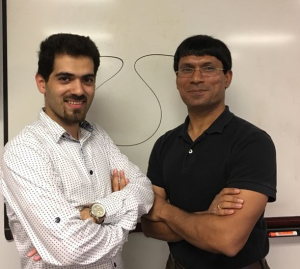In the high-energy world of Ashutosh Agrawal, assistant professor of mechanical engineering, two things turn the head of the man who always seems to be spinning with excitement about science: Discovering how nature works and seeing what happens when students understand it.
“The two best parts of this profession are when you discover something fundamental and when you see that spark of understanding in a student’s eyes when you explain it,” said Agrawal.
Both of those things happened for him while doing the research on cellular transport that was published in the Royal Society of Chemistry’s journal Soft Matter under the name “Clathrin polymerization exhibits high mechano-geometric sensitivity.” In the article Agrawal unravels the fundamental principles of transport to discover how cells adapt to changes in their mechanical environment.
Soft does matter
To understand Agrawal’s work you first have to consider a cell itself, surrounded by a membrane made of a soft fluid wall, which defines its identity and serves as a barrier to foreign objects. But macromolecules like nutrients need to continuously penetrate the membrane and enter the cell to help it survive. In that case, when the wall doesn’t want to break, but is being nudged to, proteins within the cell recognize they’re being called to duty.
“When that happens, these clathrin molecules, or proteins, come and dock on the inside of the membrane and they start to bend the membrane wall to allow the foreign cargo to enter,” said Agrawal. The proteins work to reshape the cell membrane, forming a vesicle to allow the substance in and then reforming around it without ever having to break – a process called endocytosis.
“Much is known about how tension modulates cellular transport, but the effect of tension on the clathrin assembly and vesicle growth remains less understood,” said Agrawal.
Until now.
Through computer modeling and cellular experimentation, Agrawal, with his Ph.D. students Ehsan Irajizad and Nikhil Walani and collaborators at the University of Michigan--Ann Arbor, unlocked part of the mystery by quantifying the price clathrin pays to remodel the membrane.
Studying at a cellular level
Agrawal first studied the energetics of vesicle formation in response to changes in tension of the membrane. “We find the polymerization of the protein is sensitive to tension and the geometry of the membrane,” said Agrawal. It’s like a circular path: The protein comes first to deform the membrane, but then the protein is affected by its very change. The study reveals that both the tautness and the geometry of the membrane determine the extent to which clathrin can polymerize. Contrary to intuition, the study shows that clathrin can form large domains both in low and high tension regimes. While the shape in the low tension regime is spherical, the shape in the high tension regime is planar. This finding reveals that clathrin can assemble into these distinct structures by a unified mechanism regulated by tension, which has been a subject of debate in the biology literature.
Knowing this moves Agrawal closer to understanding how cellular transport adapts to mechanical stresses, which makes him smile with glee.
Eventually the research may find its way to supporting drug delivery research, but for Agrawal the driving force is the one accomplished – recognizing the physics of why nature does what it does.
